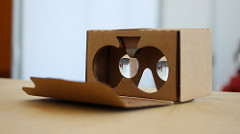It was on Monday morning when I found out that one of our librarians had visited the office next door to show a coworker the Google Cardboard she had received in the Sunday New York Times. I became indignant. “You had Google Cardboard next door to me, the Educational Technology Specialist, and you didn’t tell me!” I was only joking, but it didn’t take long for the librarians to realize that somewhere in the building sat a Google Cardboard device from Kalamazoo College’s subscription to the Sunday Times. One rescue from a blue recycling container later, we had it and began experimenting.
For a reader who hasn’t yet tried it or heard about it, Google Cardboard is a deceptively simple device that uses a cardboard housing with two lens to convert your smartphone into a 3D, virtual reality viewer.
 Title: Google Cardboard 2 Author: Maurizio Pesce
Title: Google Cardboard 2 Author: Maurizio Pesce
Source: Photo License: CC BY
As someone who has spent the week with one and works in Ed Tech, I wanted to offer my reactions. First, almost everyone I showed the device to was some version of excited. Two people went and bought their own that day. Even though the technology has precedents, the box combined with the computing and display power of the phone is impressive and new. The biggest surprise to me was how immersive it truly feels with the introduction of fully rotational space, 360-degrees. You would think that putting your face up to some cardboard lens would be dull but the field of vision, the proximity of the image, and the motion reaction is a gripping integration. I often feel like I’m in these environments and my senses are effected by what I see. I enjoy “Evolution of Verse” from VRSE in particular because of the jarring sensation of being in the womb with a (by comparison) giant fetus. It is unnerving and that sensation is a testament to the tech.
Right now, there are some technical limitations. The inexpensive plastic lens in something like a $20 Google Cardboard device introduces a grainy, lo-res illumination to everything. The image is rarely as brilliant and clean as what you see on your phone. That’s too bad. There are more expensive viewers, but I’ve already found that the popular one from ViewMaster will not accommodate my glasses so that’s a non-starter for me. I’d love something with a higher quality, less-mediating lens that fits over my spectacles. Also, these files are typically downloaded onto my phone, and they’re huge. A one-minute experience can take a gigabyte.
Thinking of “serious uses,” particularly for higher ed, I’m very excited to see where this can go. I’m sure the design and development of applications for K-12 is going to proliferate first. Creating a rich, meaningful experience is easier at that level of intellectual depth. The potential is there, though, especially as computer graphics push boundaries. You could place students into historical situations to get the “feel” of what it was like to be there or simply observe the terrain of a historical event (I’m ready to experience the Battle of Gettysburg right now). The capabilities of the phone would let a student make choices, see the influence of those choices, and have a custom experience, very much in the spirit of serious gaming in education. Places in literature could be set up as navigable locations and scenes in film could be deconstructed from the inside. The hard sciences are already envisioning how augmented and virtual reality might let students experience medicine, physics, biology, and other fields in new ways. It goes on and on.
There’s still technical and conceptual work to make this better, and I would envision the “smaller, cheaper, better” innovation model to move rapidly to solve challenges. The imagery and lens needs to get better to feel truly “real.” We need solutions for data management and file size, especially as we envision truly immersive, geographical experiences that take hours or more to complete. Motion is still crude. How do we digitally walk while remaining physically in place? How might we take advantage of our phones’ front cameras to augment reality? I understand some apps are trying this, Google Glass-style, but many VR viewers aren’t even designed to bother. What about connectivity? Can we use our devices and networks to have shared experiences in which we exist digitally together instead of staring off in isolation? These are great opportunities for discovery and invention.
In all, super cool. One week of playing with Google Cardboard has sold me on the value. Virtual Reality has started and sputtered for a long time, but this is different. The push by a massive, capable tech company to put these affordably into the hands of more people is going to drive software and hardware improvements. We’ve reached a critical mass of digital resources that can make these experiences sensually impressive and cognitively gripping in a way the most VR has not been so far. As someone working in educational technology, I fully expect these devices to have a major presence in my field probably faster than most of us anticipate.
